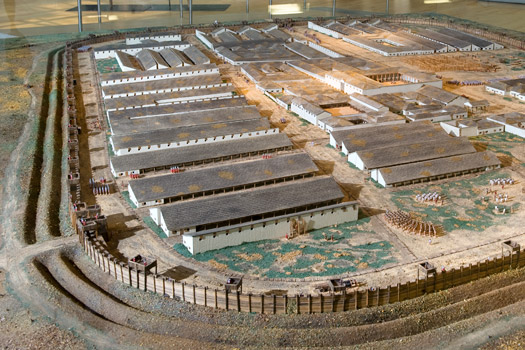
Römerlager entlang der Lippe
Zahlreiche Bodendenkmale entlang der Lippe dokumentieren den gescheitereten Versuch der Römer das rechtsrheinische Germanien zu beherrschen.
© Foto Dietrich Hackenberg
Herrschaft zurück zur Auswahl
Roman Encampments along the Lippe A failed attempt to conquer Germania
Around the time of the birth of Christ, the Roman Empire attempted to pacify “Germania libera” east of the Rhine. The highest priority for Rome in these “Germania Wars“ was to secure the Rhine border; there are still debates as to whether or not it was intended to build a permanent Roman province east of the Rhine.
In order to survive in hostile Germania, Romans were dependent on infrastructure, such as secure roads and, in particular, rivers like the Lippe, which empties into the Rhine. This river was easily navigable and served as a central supply connection.
For this reason all Westphalian Roman encampments were located close to the Lippe: Evidence of encampments have been found in Holsterhausen near Dorsten, Haltern, (Lünen-)Oberaden, (Lünen)Beckinghausen and in Anreppen. Our current knowledge about these military encampments comes from the written records of ancient writers and from archaeological excavations. The Roman strategy in the region east of the Rhine could be reconstructed on this basis, and glimpses into the daily life and organization of the Roman military became possible.
In contrast, little is known about the culture of the Germanic peoples. Because of an absence of written Germanic sources, research relies on Roman writers. Among the Germanic objects often found during excavations are also many Roman weapons and everyday objects, which had either been looted or traded. However, the degree to which Germanic peoples were influenced by Roman culture remains unclear for the area east of the Rhine.
It is equally difficult to name the Roman impetuses in “Germania Libera“: Germanic peoples had some knowledge about Roman culture, as well as Roman law and rule through trade and other relationships to the military encampments. Food (spices), clothing, weapons, and manual techniques (work implements) of the Romans as well as money (coins) would have spread from their encampments very quickly. However, it remains unclear whether or not civil administrative tasks for the area east of the Rhine were carried out here.
The Lippe encampments only existed for a short time; hardly more than 20 years after the first campaigns by Drusus along the Lippe (12 to 9 B.C.) Germanic tribes defeated the Romans in the Varus battle (9 A.D.). The revolt reveals the majoritarian rejection of the Roman rule east of the Rhine. As a result, Rome gave up all of its bases here. Later Roman advancements along the Rhine ended without resulting in any permanent bases. Rome concentrated itself on securing the area west of the Rhine. Next to Cologne, Rome erected a second settlement Ulpia Traiana in around 100 A.D, what is today Xanten, for “colonia“.
Denkmale zum Impuls
Bergkamen - Römerlager Oberaden
Im Jahre 11 v. Chr. entstand auf dem »Burghügel« des heutigen Bergkamener ... weiter
Haltern - Römerlager
Das römische Reich griff in der Regierungszeit von Kaiser Augustus (27 v. Chr. bis 14 n. ... weiter
